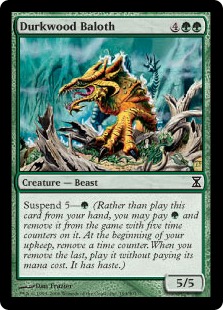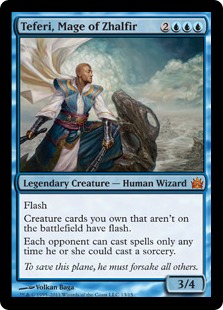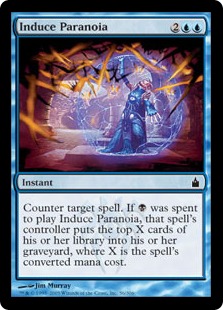
Critiquing Wizards of the Coast on their product is easy. We point fingers and mock various indiscretions. It is easy. Therefore, I am undertaking the endeavor of designing my own set. My objective is learning. Nothing beats hands-on experience and troubleshooting problems to expand my skills. I'm a big believer in skills being transferable from job to job. My hope is I can learn from this experience and transfer the lessons learned in building a set to the other areas of my life.
The Big Picture
The first task on the list is to pick a theme, build a world, or pick a mechanic. Design can tackle this issue from many angles. It won't be an issue here. My uncanny affection for time has already decided the problem for me. This automatically brings up the semi-loved suspend mechanic from the Timespiral block. The mechanic polarized the Magic player populace. Some people loved it; others hated it. Thus, I didn't just want to repeat the mechanic verbatim. The mechanic also had a lot of issues. Sad. Really. Very rarely does something get introduced into Magic that is completely new. Most mechanics can be linked to predecessors before them. My first decision was to sit down and examine the suspend mechanic. Personally, I loved the mechanic, but I'm not here to play nice.
To me, the worst flaw with the mechanic is the decision tree that develops from the mechanic or lack of it. There weren't a whole lot of decisions to be made. If a suspend card was drawn early, you suspended the card. If a player drew it late, it was played normally. I'm not going to suspend Durkwood Baloth on turn five. Besides Greater Gargadon, there wasn't a choice to be made beyond the initial suspension. This isn't good for the game when a mechanic puts a player on autopilot. Cards like Lotus Bloom exacerbated the problem by not allowing for a choice. We take away choices: Magic no longer becomes a game.

Another major flaw was the lack of hidden information. The one thing I hated about the mechanic was the lack of surprise. When I suspended Greater Gargadon or Lotus Bloom, my opponent had all the information available to strategize against my plays. It was very easy for the opponent to sandbag whatever removal was needed to neutralize the threat imposed by a suspend card. Hidden information is important. It is the reason we don't show players our hands or library. I felt in many ways I might as well have been playing with my library revealed because in many ways: suspending a card felt very similar.

The Journey Forward
I haven't spent much time world building. I wanted to nail down my major mechanic before moving forward. The next few paragraphs will give the illusion that the mechanic congealed instantaneously. From start to finish, I've spent the last month contemplating and racking my brain over the problems above. It has given me an appreciation for the columns on the mothership explaining the development of a set/mechanic/theme in brief. Those articles are only snippets of the work devoted to any particular aspect of a set. They don't do justice to the endless debates, sleepless nights, and heated arguments that goes on behind those vaulted doors. Personally, I enjoyed my arguments with myself. The people on the bus looked at me strange though.
My initial thoughts were of morph. It was a mechanic that created a great deal of suspense in the game. What was under there? Was it Skinthinner? Wait. My opponent has plains. Yup, it was definitely Exhalted Angel; one of few morphs to survive the days of Onslaught. I liked the idea of designing something similar for suspend. Morph was and still is a great mechanic. People loved it. If I remember right, Legions was one of the best selling sets of all time. However, this reared up all sorts of problems. The popular morph mechanic was fixed by creating a standard. This meant my new mechanic would have to be standardized as well. How?
The first attempt was to standardized "hidden suspend" by creating what I called critical. The idea was a player removed a card from the game face down. After a defined amount of turns, the player could play the spell at a reduced amount. Much like morph, there would be an additional cost. Critical was thought of as it sounds. After a player had "suspended" a card, he/she could play the card once a critical amount of counters had been reached. A problem that was quickly discovered was that standardizing the cards pushed the power level to the center. If I raised the critical cost, it pushed the power level up, but it punished commons or weaker cards. If I lowered the critical cost, I punished the higher power levels. (For clarification, the mechanic would have to be standardized due to hidden information.)
Keep in mind, the above was a problem because I was counting down. I would place four counters on a card and remove a counter each turn. It finally dawned upon me; why are we counting down? Why can't we count up? This solved a lot of issues. Every card would start at zero and thusly standardizing the mechanic. I then defined critical as the number needed for a player to play a card removed from the game face down. For example, if a card had a Critical of five (5), the player would remove the card face down. After five turns/time counters, the player may play the card for free. The key word here is the word may. As the way I would design it, the player could play a card with a Critical of five (5) with six, ten or fifty counters on it. They would only have to meet the minimum. The enticement of this was players could bluff and play the spells when they wanted to play the spells; not when the mechanic forced them to.
Done, right? Wrong. As I play tested the cards, I quickly realized I hadn't solved the problem of autopilot. I would always neo-suspend my Critical cards early and play them later in the game. Yes, the mechanic could work, but I didn't like how it played. Critical still played a lot like suspend. I wanted players to be forced into making choices. Suspend at its core is really just a cost reduction mechanic besides the few exceptions to this rule. I'm looking at you Aeon Chronicler. Critical was only a variation of a cost reduction mechanic. What I wanted was a functional mechanic. The idea of bonuses quickly crossed my mind. I could give players bonuses for suspending cards later in the game. This improved game play, but commons became very complicated with this new angle of design. *Sigh*
Weeks later, I finally realized I was making this whole thing too complicated. Why don't I just give out bonuses? People like bonuses and free stuff. Why even bother with a cost reduction? This line of thinking led me to develop what I have termed Charge. When a player removes a card from the game, that player is charging a spell. By charging a spell, that spell gets bonuses based on the number of charge counters on it. It doesn't matter if it is the beginning or later part of a game. If you want the bonus, you have to charge it. As I playtested the mechanic, I enjoyed how it played. As a designer, I really liked the mechanic for how flexible the mechanic could be designed. I had the ability to design pseudo-critical cards in the same vein as Martial Coup. For example, I could require that a certain number of charge counters must be present before that player gets a bonus from a charged card. Or, I could give a bonus for every charge. Also, I liked how it counted up. Not a big deal, but counting up is a more natural than counting down like suspend. People like counting up. The idea was sexy with its potential. Can you imagine charging a card on turn on in an EDH game and finally playing on turn 20 with 20 charge counters? Living the dream.
The semi-finalized mechanic would be Charge. Playtesting showed the mechanic had lots of room for continual design given enough time. Sorry. The one polish I gave Charge was to have players add the charge counters at the end of turn. The upkeep step is already fraught with upkeep abilities. The upkeep step is also a bad time for players to be adding counters. A lot of functions are happening at the beginning of every turn. There is untapping, the upkeep, and drawing a card. Players often miss triggers and other abilities in the first phase of a turn. To reduce these problems, I decided to put the addition of charge counters at the end of turn. A pleasant side effect was the addition of a charge counter signified the end of the turn without a player having to announce such a game situation. I can quickly see the phrase "Charge. Go." Being uttered.
The undecided part of Charge is whether to add a mana cost for having to remove a card from the game in order to start charging it. My gut is yes, but adding a cost is adding one more line text to explain the ability. I don't want to add a mana cost to an ability that is using time as a cost. If do decide to add a cost, it will only be for one generic mana. Morph cost three. Charge will cost one. For now, I will leave off the one mana. For now, here is my major mechanic.
Charge: Remove this card from the game face down. At the end of turn, place a charge counter on this card. (Charged spells follow the same timing and costs of casting a spell as if this spell were in your hand.)
Preliminary, Preliminary Example:
Wrath of Time
3WW
Sorcery
Charge
Destroy all Creatures.
You may remove a nonland permanent from the game for every charge counter on this card when it was cast.
Problem Log: Star Date 03/13/2012
That didn't last long. The mechanic needs a mana cost. Without it, turn one is pretty silly as all the Charge cards are simply removed from the game. A single generic mana cost alleviates the problem. As I played with the additional cost, I didn't find to actually be a hindrance. Choices still need to be made, but I find it to be a good thing. Do you play Llanowar Elves or start charging a spell. It creates interesting tension. On the plus side, the extra cost will allow for the spells to be costed more aggressively.
Feedback is welcome during this small miniseries. I fully acknowledge templating and rules are not my forte. I welcome any suggestions to simplify the writing of the mechanic, rules problems I need to address or criticism in general.
Charge – You may pay and exile this card from the game face down. At the end of turn, put a charge counter on this card. You may cast this spell as long as it remains exiled.
Parenthood

I guess I am one of those parents now. Like it or not, I have a baby. I'm also wondering what the hell I got myself into. It is all terrifying and exciting at the same time. Most parents never thought they'd find a peanut butter and jelly sandwich in their VCR. It is the best way I can explain how I am feeling about this project. Even thought I thought I would have learned something, I somehow I feel I'm going to get more of an education than I bargained for. For example: Should I make spells with Charge a type like Arcane spells? It works for instants and sorceries, but appears awkward on creatures or enchantments. Where should the full text appear? Full text should appear on commons, but should it be appear in full on uncommons? Should Charge appear on the top of text box or on the bottom? This is only a portion of the stuff that swirls around in my head late at night. I lost two hours of sleep the other night thinking about the frequency that Charge spells should appear in the set through the rarities and on what type of cards should they appear on. Should all the different card types get Charge? I'm starting to wonder how much sleep the members of R&D get at night.
Off Topic: Amateur Night
Since the time I have started playing Magic, the formats and variety of ways to play this game has grown considerably. There are dozens of formats and variants. One of the last ventures for this game I believe will be the growth of amateur designers. Yes, I understand a lot of forums have places where people design their own cards and occasionally create a set. What I envision are nights where amateur designers can bring their sets to a store or possibly a Grand Prix to have it drafted. On some specified night, other players can show up, draft the set, and give the designer feedback. Amateur designers will encompass a small niche of the Magic populace, but I'm surprised more of them don't exist in a more visible fashion at least. Anyway, just something that crossed my mind as I wrote this article. After my set is completed, I already have players willing to sit down to draft the set, give me feedback and a few jabs in-between.
Comments